Samsung is making all three models in its new flagship smartphone range 5G-compatible. The top-end Galaxy S20 also introduces a 100x zoom camera.
The firm also confirmed a new foldable, the Galaxy Z Flip. It uses “folding glass” in its display and small fibres in its hinge to protect itself from damage.
Several rivals plan their own handset launches over the coming weeks.
But the spread of the coronavirus poses a threat to production.
“The virus is going to affect the supply chain,” said Ben Wood from the consultancy CCS Insight.
“Although Samsung has diversified its manufacturing into places way beyond China, there will still be components in these phones sourced from China.”
Many factories in the country have delayed re-opening after its New Year break because of fears the virus could spread in the workplace. China is also the world’s biggest smartphone market, and the outbreak has hit local demand.
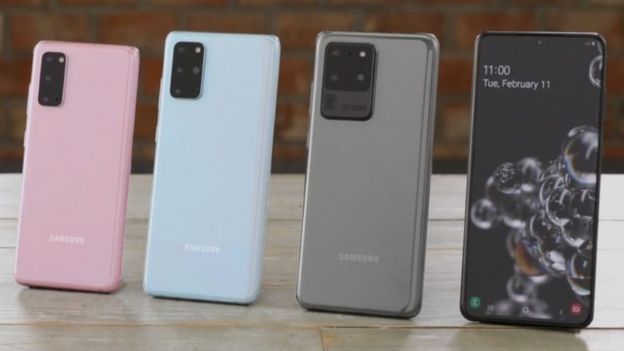
Samsung has suffered less impact than many of its rivals to date because it makes most of its handsets in Vietnam, and sells relatively few phones to Chinese consumers.
But TrendForce – a research firm – still predicts the virus will cause the South Korean firm to produce 3% fewer devices than it might have in the current quarter.
“I’m expecting that to mean some delays in delivering the new handsets,” added Francisco Jeronimo an analyst at IDC.
Samsung told the BBC it was making its “best effort to minimise impact on our operations”.
Smarter shots
There are three S20 variants:
- the basic model with a 6.2in (15.7cm) display. It has three rear cameras: a 64-megapixel telephoto lens, a 12MP wide and a 12MP ultra-wide. It starts at $999/£799
- the S20+ has a 6.7in (17cm) display. It adds a depth sensor to the basic model’s array. It starts at $1,199/£999
- the S20 Ultra has a 6.9in (17.5cm) display. Its telephoto lens is only 48MP, but the wide-angle lens is bumped up to 108MP. It starts at $1,399/£1,199
The S20 Ultra’s camera module is thicker than that of the others to incorporate a periscope. This uses a prism to reflect light into the device’s interior, allowing the wide-angle option to feature a longer lens and bigger sensor.
Although it is possible to take 108MP shots, owners are expected to let the phone automatically merge groups of nine pixels into one most of the time. This aids low-light photography.
The 100x “super-resolution zoom” facility uses the lower-resolution 48MP camera. Machine-learning techniques stitch together pixels from up to 20 different frames to achieve a better result than would be possible via a simple digital zoom.
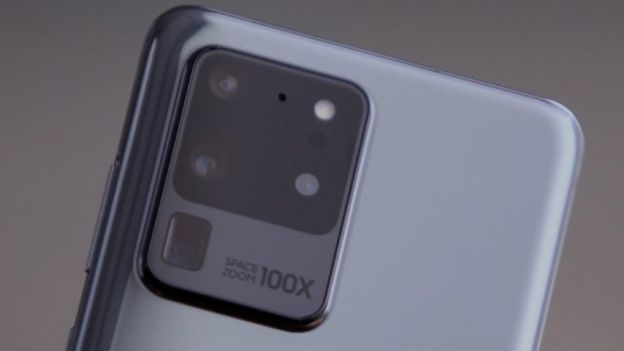
It allows Samsung to boast double the zoom range of Huawei’s competing P30 handset, although one expert questioned how usable it was in practice.
“The 100x zoom ends up with a quite blurred image, so I don’t think people will turn to it that often”, commented Mr Jeronimo.
“But it should have a wow factor when shown off in stores. And at 20x to 30x you can get a good photo.”
The phones also introduce Single Take mode. Samsung said this uses artificial intelligence to simultaneously take a mix of stills and videos via the various cameras, giving the owner a selection to choose from after the fact.
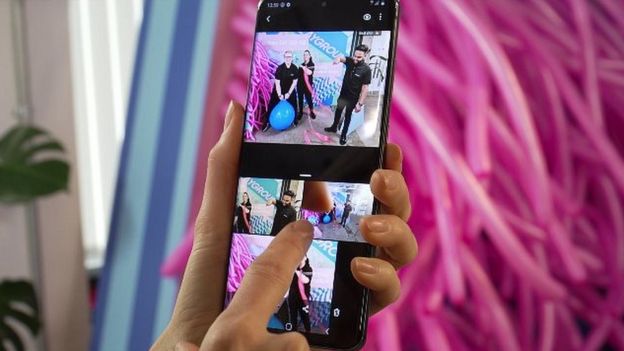
“We want to make sure consumers can really enjoy the moment in front of them… and don’t have to worry about adjusting settings,” explained product manager Mark Holloway.
The phones are also among the first to be capable of recording in 8K resolution – four times as many pixels as 4K and 16 as many as 1080p high definition.
Most people do not yet own 8K screens, but Samsung suggests this offers a degree of future-proofing as well as the ability to extract high-quality stills from the footage.
 “Both the new tech and the more user-friendly user interface should help with how Samsung’s camera functionality is perceived,” commented Carolina Milanesi from Creative Strategies.
“Both the new tech and the more user-friendly user interface should help with how Samsung’s camera functionality is perceived,” commented Carolina Milanesi from Creative Strategies.
“Its results in the past were not quite on a par with competitors, perhaps signalling it wasn’t leveraging software to do the heavy-lifting as much as the likes of Apple and Google. This time round there is definitely more ‘AI’ involved.”
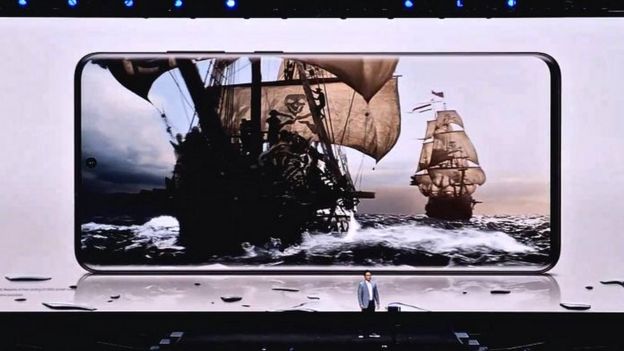
5G future
Samsung is pitching gaming as one benefit of having 5G connectivity, suggesting that lower latencies will mean that players can see and react to events in online titles split-seconds faster than if they were on 4G.
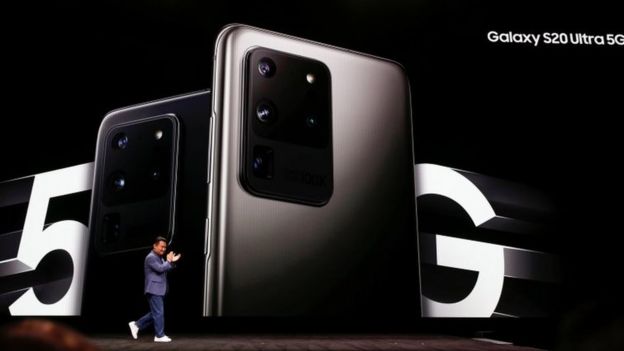
The phones’ Google Duo app also displays video chats in higher quality when on 5G.
Networks are still in the early stages of deploying the technology, but one consultant said it was still wise to offer it as standard.
“Consumers are holding on to their phones for three or four years, and don’t want something that will become obsolete in that lifetime,” said Ben Wood.
“And this launch represents a unique opportunity: Huawei is on the back foot as it doesn’t have access to Google’s suite of apps, and Apple currently doesn’t have a 5G-capable iPhone.”
Wallet-sized phone
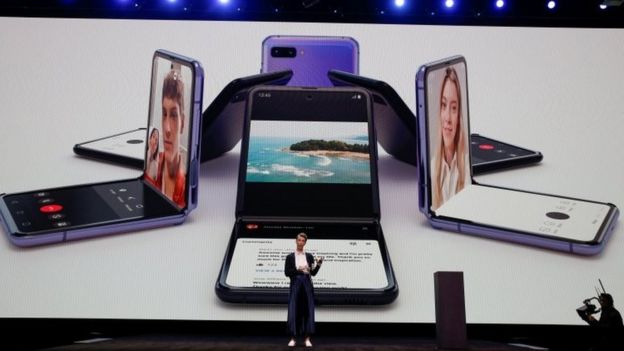
The Z Flip, however, is limited to 4G.
Several of its features – including a clamshell design with a small display on the outside and a 6.7in foldable screen on the inside – had already been revealed by Samsung in a TV advert on Sunday.
It represents the firm’s second attempt at a foldable after the troubled launch of the Galaxy Fold tablet-phone hybrid.
This time round, the concept is a tall-screened phone that can be used one-handed when opened, and made wallet-sized when closed.
The hinge mechanism has also evolved. It now incorporates tiny brushes to sweep away dirt and dust particles. In addition, it can hold the device partially open, which Samsung is pitching as being helpful for taking selfies or recording vlogs.
The firm says it can be opened and closed more than 200,000 times.
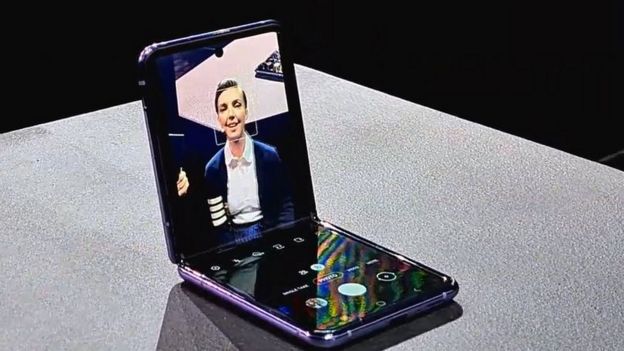
The other big change is to the display, which now features a substance Samsung calls “folding glass”.
“You clearly notice that the screen is much more resistant than the Fold’s, which should reduce the risk of scratching,” said Mr Francisco.
“It’s still probably not as resistant as a normal smartphone, but you can feel its quality.”
The Z Flip will cost $1,380 in the US and £1,300 in the UK and becomes available on 14 February.
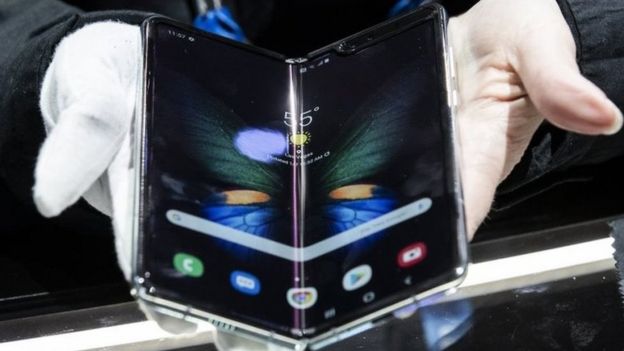
It will compete with Motorola’s Razr, which has a similar design. But both are expected to sell in far smaller quantities than the S20 range.
“There’s a lot of excitement around this new category, but [for most] they are prohibitively expensive,” said Paolo Pescatore from PP Foresight.










